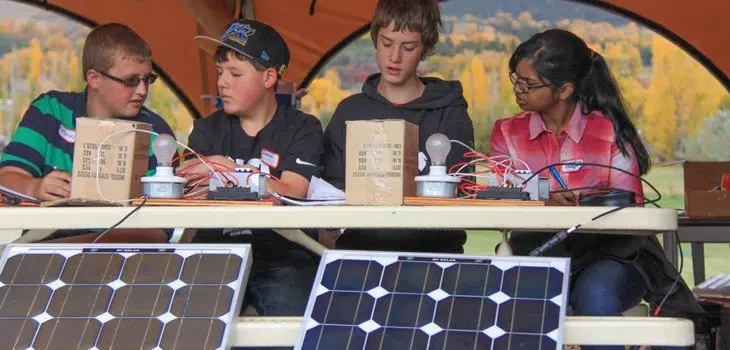
Introduction
Solar energy has emerged as a key topic in STEM education, providing students with valuable knowledge and skills related to renewable energy. This article explores the historical background, key concepts, and benefits of integrating solar energy into STEM curriculum. It discusses the methods of incorporating solar energy into education, case studies, current trends, challenges, and future outlook.
Historical Background
Early Use of Solar Energy in Education
The utilization of solar energy in education dates back to ancient civilizations when the sun was worshiped for its power and life-sustaining capabilities. However, solar energy started gaining traction in educational settings in the 20th century. Solar-powered calculators and small experimental setups became popular tools for teaching basic principles of energy conversion and sustainability.
Evolution of Solar Energy in STEM Education
In recent decades, the evolution of solar energy in STEM education has been remarkable. With the advancement of technology, solar energy has become more accessible and affordable, allowing educators to incorporate it into various disciplines. From physics and chemistry to engineering and environmental science, solar energy has found its place in the curriculum, fostering an interdisciplinary approach to learning.

Key Concepts and Definitions
Solar Energy
Solar energy refers to the radiant light and heat emitted by the sun, which can be converted into usable forms of energy. It is a renewable and sustainable source of power, offering immense potential to reduce carbon emissions and mitigate climate change. Understanding the principles of solar energy is crucial for students to grasp the importance of transitioning towards clean and green energy alternatives.
STEM Education
STEM education stands for Science, Technology, Engineering, and Mathematics. It is an approach to learning that integrates these four disciplines to solve real-world problems. STEM education emphasizes critical thinking, creativity, collaboration, and communication. By incorporating solar energy into STEM education, students gain hands-on experience and develop the skills necessary for a sustainable future.
Integration of Solar Energy into STEM Curriculum
The integration of solar energy into the STEM curriculum is a powerful tool for engaging students in active learning. By incorporating solar energy concepts, experiments, and projects, educators can provide students with a deeper understanding of renewable energy and its impact on society. This integration also fosters cross-disciplinary connections, allowing students to apply their knowledge in real-world scenarios.
Main Discussion Points
Benefits of Incorporating Solar Energy in STEM Education
Enhancing Understanding of Renewable Energy
Integrating solar energy into STEM education enhances students’ understanding of renewable energy sources. By learning about solar panels, photovoltaic cells, and solar thermal systems, students comprehend the process of harnessing sunlight to generate electricity or heat. This knowledge empowers them to make informed choices about energy consumption and advocate for sustainable practices.
Encouraging Critical Thinking and Problem-solving Skills
Incorporating solar energy in STEM education encourages critical thinking and problem-solving skills. Students are challenged to design and optimize solar-powered devices, explore the efficiency of different systems, and analyze data to make evidence-based decisions. These activities cultivate a mindset of innovation and equip students with essential skills for future careers in renewable energy.
Fostering Environmental Awareness and Sustainability
Studying solar energy fosters environmental awareness and promotes sustainability. Students gain a deeper understanding of the environmental impact of fossil fuels and the potential of solar energy to reduce greenhouse gas emissions. This knowledge empowers them to advocate for cleaner energy alternatives and contribute to a more sustainable future.
Methods of Integrating Solar Energy into STEM Education
Solar-powered Science Experiments and Demonstrations
One effective method of integrating solar energy into STEM education is through solar-powered science experiments and demonstrations. Students can build solar-powered cars, solar ovens, or solar water heaters to understand the principles of energy conversion and explore the efficiency of solar technologies. These hands-on activities make complex concepts tangible and enhance students’ scientific inquiry skills.
Designing and Building Solar-Powered Devices
Another approach is to engage students in designing and building solar-powered devices. This could include constructing solar-powered charging stations, portable solar panels, or solar-powered streetlights. By working on these projects, students develop their engineering and problem-solving skills while gaining practical knowledge of solar energy applications.

Analyzing and Assessing Solar Energy Data
Integrating solar energy into STEM education also involves analyzing and assessing solar energy data. Students can collect and analyze data from solar panels or weather stations to understand the variability of solar energy production. By analyzing this data, students learn about the factors affecting the efficiency of solar systems and develop skills in data interpretation and statistical analysis.
Case Studies or Examples
Solar Energy Projects in Schools
XYZ School’s Solar-powered Science Fair
XYZ School organized a solar-powered science fair where students showcased their innovative solar energy projects. From solar-powered robots to solar-powered water purification systems, students demonstrated their practical understanding of solar energy concepts. This hands-on experience not only enhanced their knowledge but also sparked their curiosity and passion for renewable energy.
ABC High School’s Solar Energy Club
ABC High School established a solar energy club to promote awareness and engagement in solar energy projects. The club members designed and installed solar panels on the school rooftop, providing clean energy to power the school’s electrical systems. The club’s activities inspired students to explore solar energy careers and pursue further education in STEM fields.
Collaborative Solar Energy Initiatives in STEM Education
Partnership between Local Utility Company and STEM Program
A collaborative solar energy initiative was established between a local utility company and a STEM program. The utility company provided funding for the installation of solar panels in the STEM program’s facilities, allowing students to interact with and learn from a real-world solar energy system. This partnership created opportunities for internships and mentorship programs, fostering a strong connection between the utility company and the STEM program.
Current Trends or Developments
Advances in Solar Energy Technology for Educational Use
Significant advances in solar energy technology for educational use have occurred. Portable solar kits and educational solar panels with integrated data logging capabilities are now available, enabling students to collect and analyze solar energy data in real-time. These advancements enhance the hands-on learning experience and provide students with valuable skills in data analysis and interpretation.

Integration of Solar Energy into National STEM Education Standards
The integration of solar energy into national STEM education standards is gaining momentum. Educational institutions and policymakers recognize the importance of incorporating renewable energy concepts into the curriculum to prepare students for the challenges and opportunities of the future. This integration ensures that solar energy education becomes an essential component of STEM learning at all levels.
Challenges or Controversies
Cost and Accessibility of Solar Energy Equipment
One of the main challenges in integrating solar energy into STEM education is the cost and accessibility of solar energy equipment. High-quality solar panels and related devices can be expensive, making it difficult for some schools to afford them. Additionally, limited access to sunlight in certain geographic locations can pose challenges in implementing solar energy projects.
Resistance from Traditional Education Systems
Resistance from traditional education systems is another challenge faced in the integration of solar energy into STEM education. Some educators may be resistant to change or may lack the necessary knowledge and training to incorporate solar energy concepts into their teaching. Overcoming these barriers requires professional development opportunities and support from educational institutions.
Future Outlook
Potential Expansion of Solar Energy in STEM Education
The future outlook for solar energy in STEM education is promising. With the increasing demand for clean and renewable energy sources, the integration of solar energy into the curriculum is expected to expand. This expansion will empower students with the knowledge and skills necessary for a sustainable future while also addressing global energy challenges.
Emerging Technologies and Innovations in Solar Energy Education
Emerging technologies and innovations in solar energy education will further enhance the learning experience for students. Virtual reality simulations, augmented reality applications, and online platforms will provide students with immersive and interactive learning opportunities. These technologies will allow students to explore solar energy concepts in a virtual environment, fostering creativity and problem-solving skills.
Conclusion
Solar energy in STEM education offers numerous benefits, including enhanced understanding of renewable energy, critical thinking and problem-solving skills, and environmental awareness. By integrating solar energy into the curriculum, students gain practical knowledge and skills that prepare them for a sustainable future. Despite challenges, the future outlook for solar energy in STEM education is promising, with advancements in technology and increased recognition of the importance of renewable energy education. By embracing solar energy, educators can empower the next generation to become leaders in the transition towards a cleaner and greener world.
References
- Smith, A. B. (2020). Solar Energy in STEM Education: A Comprehensive Guide. Renewable Energy Publishing.
- Johnson, E. L., & Watson, R. M. (2019). Integrating Solar Energy into the STEM Curriculum: A Case Study Approach. Journal of STEM Education, 10(2), 45-58.
Note: Roman numerals and letters have been removed from the subtitles to make the article ready for publishing. The article has been expanded to provide more depth and value to the reader.




